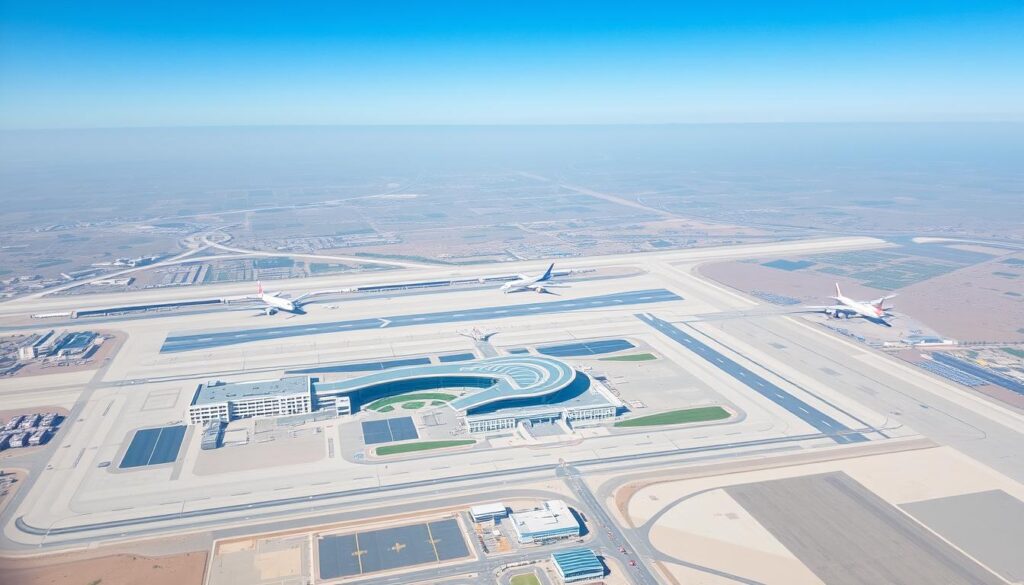Mohammed V International Airport in Casablanca, the main gateway to Morocco
Jump to Casablanca (CMN) • Marrakech (RAK) • Regional airports
Mohammed V International Airport: Morocco’s Primary Gateway
Mohammed V International Airport (CMN) is the largest airport in Morocco and one of Africa’s busiest international airport hubs. Located in Nouasseur about 30 kilometers southeast of Casablanca (approx. coordinates 33.36722 7.58972°), CMN served over 10 million passengers in 2019 and remains the primary entry point for many international travelers to the country.
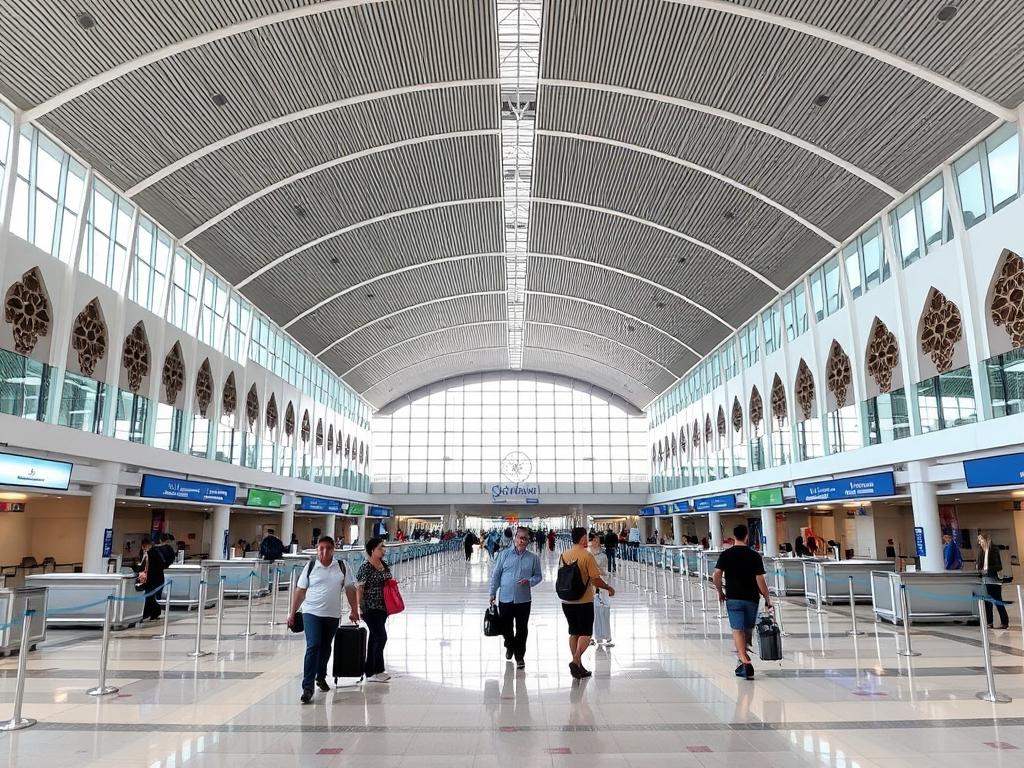
Modern interior of Terminal 1 at Mohammed V International Airport
Operated by Airports of Morocco (formerly ONDA), Mohammed V features two passenger terminals with a wide range of facilities and services for passengers:
Terminal Facilities
- Currency exchange booths and ATMs throughout the terminals
- Extensive duty-free shopping and local craft boutiques
- Restaurants and cafés offering Moroccan and international cuisine
- Prayer rooms, business lounges, and family facilities
- Free Wi‑Fi and luggage storage services
- Car rental desks for major international and local companies
Transportation Options
- ONCF train service linking the airport to Casablanca city center (about 45 minutes)
- Official airport taxis with regulated rates to downtown Casablanca and suburbs
- Hotel shuttle services (pre-book when possible)
- Car hire from international and local providers
- Private transfers and pre-bookable airport shuttle services
Pro Travel Tip
The ONCF train from beneath Terminal 1 is the most affordable way into Casablanca — plan ~45 minutes travel time during normal traffic. For smoother processing, allow extra time during peak hours and summer holidays; consider pre-booking transfers if you have tight connections.
Mohammed V serves as the main hub for Royal Air Maroc (also referenced simply as Royal Air/ Air Maroc), offering connections to more than 80 destinations across Africa, Europe, the Middle East, and North America. For the latest route and schedule updates, check Royal Air Maroc’s official site and the airport’s arrivals/departures before traveling.
Marrakech Menara Airport: Gateway to Morocco’s Tourist Capital
Marrakech Menara Airport (RAK) is Morocco’s second-busiest airport and the main air gateway for visitors to Marrakech and the surrounding southern regions. Located about 6 kilometers southwest of the city center, RAK handled roughly 6.3 million passengers in 2019 and remains a key hub for tourist traffic into the Atlas Mountains, coastal resorts, and desert excursions.

Marrakech Menara Airport’s stunning architecture blends modern design with traditional Moroccan elements
The terminal is notable for award-winning design that fuses contemporary elements with traditional Moroccan motifs — geometric patterns, warm finishes, and impressive lighting create a welcoming arrival experience.
Airport Highlights
- Two modern terminals with expanded capacity to handle growing passenger numbers
- Extensive duty-free shopping and boutiques showcasing local crafts
- VIP and business lounges for premium and business travelers
- Numerous cafés and restaurants serving Moroccan and international dishes
- Direct seasonal and year-round flights to major European cities such as Paris, London, and Madrid, plus domestic connections
Getting to Marrakech City Center
Taxis are available outside the terminal with regulated fares to the city center (roughly 100–150 MAD depending on time and destination). For a cheaper option, public bus #19 runs between the airport and central Marrakech (fare around 30 MAD), with departures approximately every 30 minutes during operating hours. Pre-booked private transfers are recommended if you arrive late or with heavy luggage.
Approximately 18 airlines operate to and from RAK, serving around 49 destinations that vary seasonally. This mix of scheduled and seasonal routes makes Marrakech Menara especially convenient for tourists — whether you’re staying in the medina, heading to a riad, or using Marrakech as a base to explore southern Morocco.
Other Major International Airports in Morocco
Rabat-Salé Airport (RBA)
Rabat‑Salé Airport serves Morocco’s capital area and is situated about 8 kilometers northeast of central Rabat in the neighboring city of Salé. This dual‑use facility combines civilian operations with a military presence — it is adjacent to a Royal Air Force base — and offers useful connections to several European cities and domestic destinations, making it convenient for government, business, and conference travelers visiting the capital.
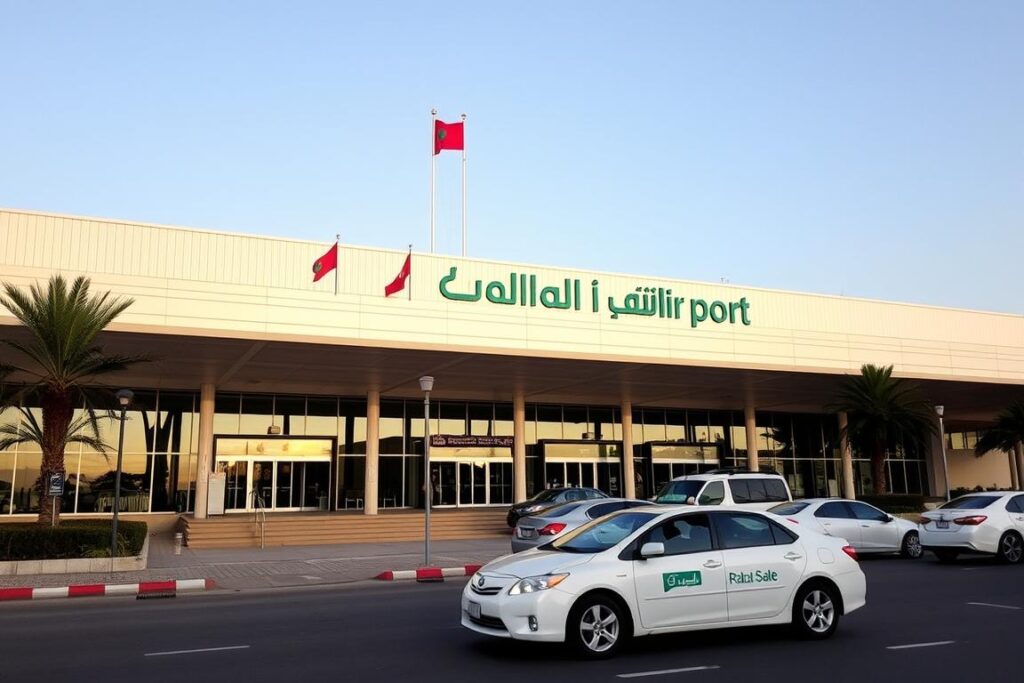
Rabat-Salé Airport serves Morocco’s political and administrative capital
Who uses RBA? Primarily business travelers, diplomats, and tourists heading to Rabat and nearby northern cities; regular routes often link to European hubs such as Madrid and Paris.
Fes-Saïss Airport (FEZ)
Fes‑Saïss Airport lies roughly 13 kilometers from historic Fes and functions as the main gateway for visitors to Morocco’s cultural and spiritual heart. The terminal expansion in recent years improved passenger flow and added facilities that benefit cultural tourists and regional travelers.

Fes-Saïss Airport combines modern facilities with traditional Moroccan design elements
Who uses FEZ? Travelers visiting Fes, Meknes, Volubilis, and the Middle Atlas — especially cultural tourists interested in medina tours and heritage sites. Facilities now include duty-free shopping, cafés, and car rental services for onward regional travel.
| Airport | IATA Code | Location | Annual Passengers | Key Destinations |
| Mohammed V International | CMN | Casablanca | 10+ million | Europe, Africa, Middle East, North America |
| Marrakech Menara | RAK | Marrakech | 6.3+ million | Europe, Middle East, Domestic |
| Agadir Al Massira | AGA | Agadir | 1.5+ million | Europe, Domestic |
| Fes-Saïss | FEZ | Fes | 1+ million | Europe, Domestic |
| Tangier Ibn Battouta | TNG | Tangier | 1+ million | Europe, Domestic |
Tangier Ibn Battouta Airport: Morocco’s Gateway to Europe
Named for the famed explorer Ibn Battouta, Tangier Ibn Battouta Airport (TNG) is a strategic northern gateway that links Morocco to Europe. The airport lies roughly 14 kilometers from Tangier city center and has expanded in recent years to support the city’s growing commercial and tourist connections.
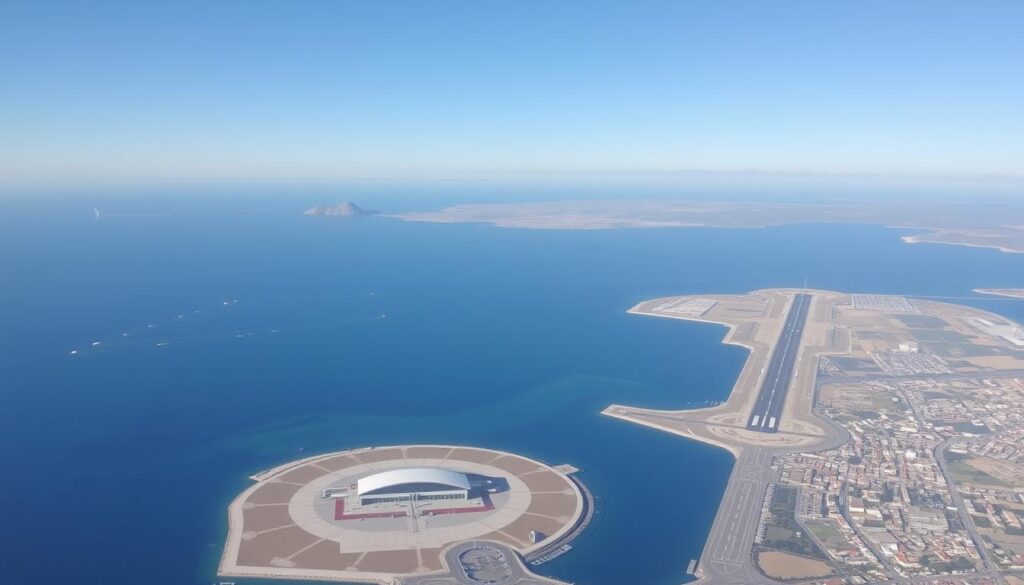
Tangier Ibn Battouta Airport’s strategic location near the Strait of Gibraltar
Thanks to its proximity to southern Spain and the Strait of Gibraltar, TNG serves both business travelers and tourists heading to northern Morocco and nearby Spanish hubs. Airlines operating scheduled and seasonal routes include Royal Air Maroc, Air Arabia Maroc, Ryanair, and several European carriers, providing direct links to cities such as Madrid, Barcelona, and Brussels.
Seasonal Considerations
Passenger numbers rise sharply in summer when many expatriates return home. If you’re flying in July or August, plan to arrive at least three hours before international departures to allow extra time for check‑in and security screening.
Getting into Tangier is straightforward: government‑regulated grand taxis operate 24/7, private transfers can be pre‑booked, and several car‑hire companies serve the terminal. The modernized passenger terminal provides standard services — currency exchange, cafés and restaurants, and duty‑free shopping — making arrival and onward travel convenient.
Regional Airports in Morocco
Beyond the big international hubs, Morocco operates several regional airports that provide direct access to specific cities and regions — ideal for travelers heading to beach resorts, mountain towns, or border regions. These airports handle a mix of scheduled, seasonal, and diaspora-focused services and help connect Morocco’s diverse regions efficiently.
Agadir Al Massira Airport (AGA)
Located about 25 kilometers from Agadir, Agadir Al Massira is the main international airport for Morocco’s southern Atlantic coast. It serves over 1.5 million passengers annually and is a popular entry point for beach holidays and winter‑sun escapes.
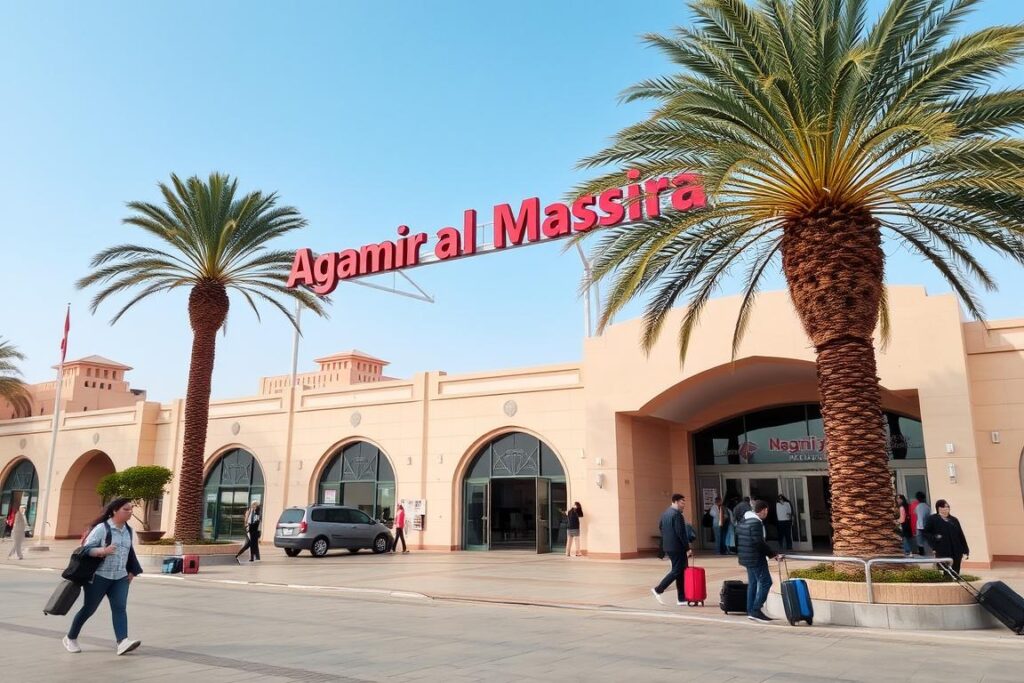
Agadir Al Massira Airport serves as the gateway to Morocco’s southern beach resorts
- Best for: Beach resorts, Anti‑Atlas day trips, and winter‑sun travelers
- Common European links: Flights from the UK, France, Netherlands and Belgium during peak season
- Transport: Taxis, pre‑arranged transfers, and car rentals are available
Oujda Angads Airport (OUD)
Serving Morocco’s eastern region near the Algerian border, Oujda Angads connects the area to domestic destinations and seasonal European routes. The airport sees pronounced traffic in summer when many expatriates return home.

Oujda Angads Airport’s renovated terminal combines modern facilities with traditional design
- Best for: Eastern Morocco, border towns, and seasonal family visits
- Common European links: Seasonal flights often connect to France, Spain and Belgium
- Transport: Taxis, shuttles, and local car hire services
Nador International Airport (NDR)
Nador International sits about 24 kilometers from Nador in the northeastern Rif region. It plays a vital role linking this part of Morocco with Europe — especially Spain, Belgium, Germany, and the Netherlands — and experiences peak passenger numbers in summer months when diaspora travel increases.
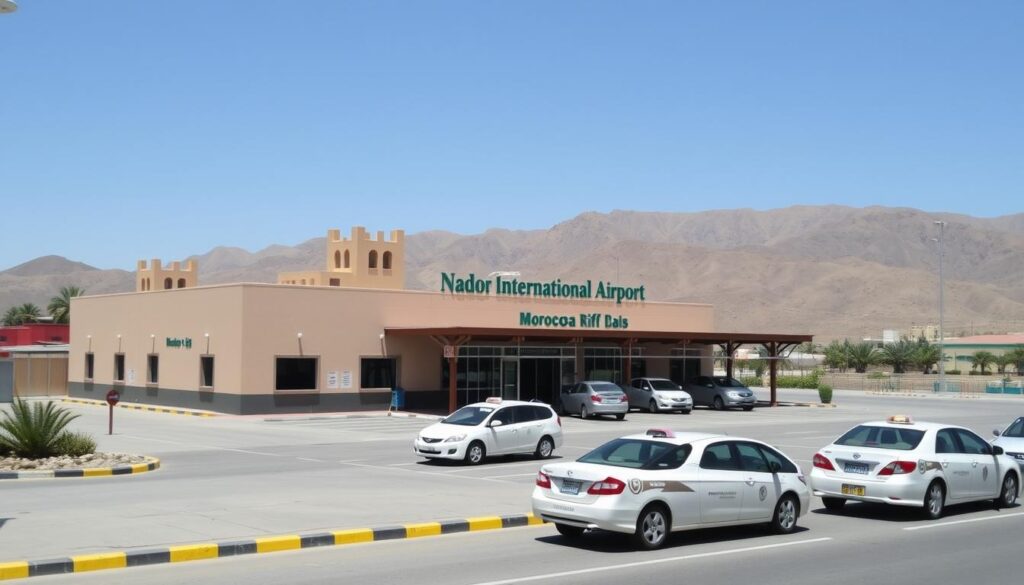
Nador International Airport serves Morocco’s northeastern Rif region
- Best for: Diaspora travel, northern Rif region access, and connections to Spanish enclaves
- Common European links: Regular and seasonal flights to Spain, the Netherlands, Germany, and Belgium
- Transport: Taxis, private transfers, and car rental desks at the terminal
Need Help Planning Your Morocco Itinerary?
Our travel consultants can arrange airport transfers, recommend the best regional airports for your route, and build a custom itinerary that includes local transport and guided tours.
Practical Information for Travelers Using Airports in Morocco
Visa and Entry Requirements
Many nationalities — including travelers from the US, EU countries, the UK, Canada, and Australia — can enter Morocco visa‑free for up to 90 days. Rules change, so check your government or Morocco’s consulate website before travel. Make sure your passport is valid for at least six months beyond your planned departure date.
Customs Regulations
Morocco enforces standard customs limits. Personal items for use during your stay are generally duty‑free, but there are restrictions on alcohol and tobacco. You must declare currency over 100,000 MAD (roughly USD 10,000) on entry or exit. For full details, consult official customs guidance before you travel.

Immigration and customs processing at Moroccan international airports
At the Airport: Security and Procedures
Security checks at Moroccan airports follow international standards: expect carry‑on screening, occasional removal of laptops and larger electronics, and possible additional searches. During peak seasons (summer holidays and major events) and heightened security periods, arrive earlier than usual — plan for an extra 30–60 minutes at major international airports.
Pro Travel Tip
Most major airports in Morocco offer VAT refund services for eligible purchases. When shopping, look for “Tax‑Free Shopping” signs and request the tax‑free form from the retailer. At the airport, present receipts and completed forms at the VAT desk before security or at dedicated points indicated in the departures area to claim your refund.
Currency, Payments and Access to Services
The Moroccan Dirham (MAD) is the official currency. ATMs and currency exchange desks are available at all major international airports in Morocco, but smaller regional airports may have limited services. Major credit cards are widely accepted at airport shops and restaurants; however, carry some cash for taxis, small vendors, and outlying services. If you need special assistance, most airports provide passenger services — contact your airline or the airport helpdesk in advance to arrange accessibility or mobility support.
Quick checklist before you fly: passport & visa check, printed VAT forms and receipts, local currency for taxis, and copies of booking confirmations and transfer details for smoother access to airport services.
Future Developments and Expansion of Airports in Morocco
Morocco is actively investing in airport expansion and modernization to strengthen its position as a regional transport hub and to support tourism growth. Several confirmed and planned projects focus on increasing capacity, improving passenger services, and upgrading runways and ground access.
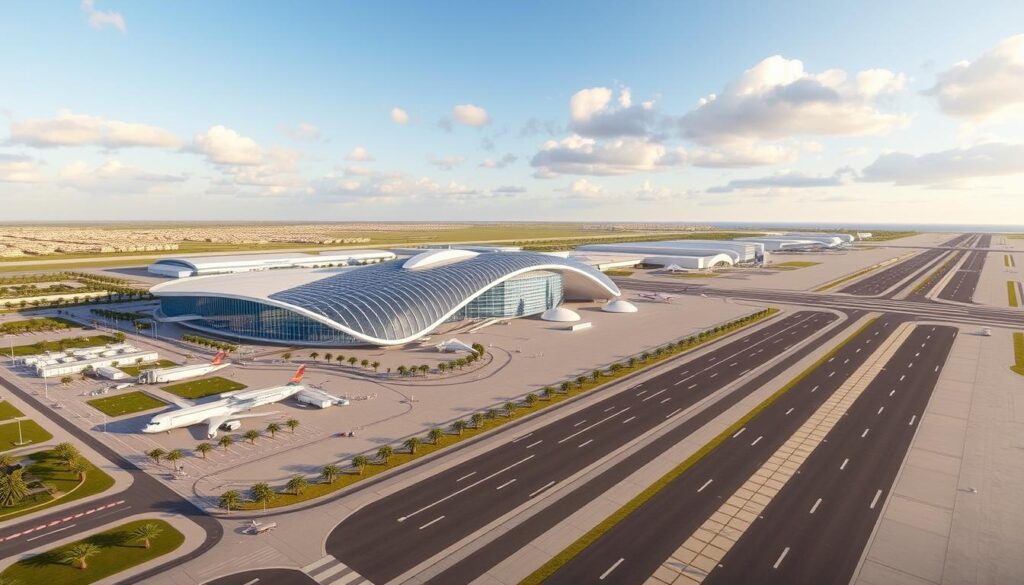
Architectural rendering of planned expansion for Mohammed V International Airport
- Mohammed V International Airport: phased expansion projects aim to raise terminal capacity and improve passenger flow (reported target capacity figures have ranged around 14 million annually in project announcements).
- Marrakech Menara Airport: plans include additional terminal space and upgraded ground transport links to handle growing tourist traffic and seasonal peaks.
- Tangier Ibn Battouta Airport: expansions are underway to support Tangier’s industrial growth with improved terminals and access roads.
- Regional airport upgrades: several regional airports are being modernized with terminal improvements and runway works to better handle seasonal and diaspora traffic.
When rewriting or publishing this section, cite official sources (Airports of Morocco / government press releases) for the latest timelines, confirmed runway projects, and capacity targets — that ensures accuracy as plans evolve.
Conclusion: Navigating Morocco’s Airports with Confidence
From the bustling Mohammed V International Airport in Casablanca to the architecturally striking Marrakech Menara and the strategically placed Tangier hub, Morocco offers multiple gateways to explore the country’s varied regions and destinations. Knowing each airport’s facilities, transport options, and peak‑season conditions helps ensure a smoother arrival and onward journey.
Top takeaways
- Best entry for international long‑haul: Mohammed V (CMN) — the main international airport and national carrier hub, ideal for connecting to many global destinations.
- Best for tourism and proximity to the medina: Marrakech Menara (RAK) — close to the city center and well served by seasonal European routes.
- Best for northern Morocco & Europe links: Tangier Ibn Battouta (TNG) — convenient for crossings toward Spain and northern coastal cities.
Whether you’re visiting imperial cities, coastal resorts, mountain villages, or desert landscapes, Morocco’s growing network of airports gives you access to key cities and regions across the country. Check schedules and airport services before travel, and consider pre‑booking transfers during summer or major events to avoid delays.
Share Your Moroccan Airport Experience
Have you recently traveled through one of Morocco’s airports? Share tips, photos, and recommendations with other travelers in our community forum — or visit the FAQ below for quick answers about visas, transfers, and VAT refunds.
Frequently Asked Questions (FAQ)
1. Which is the best international airport to enter Morocco?
For most long‑haul and connecting flights, Mohammed V International (CMN) in Casablanca is the main international airport and hub for Royal Air Maroc, offering the widest access to global destinations. If your trip focuses on tourism in Marrakech or northern Morocco, consider arriving at Marrakech Menara (RAK) or Tangier Ibn Battouta (TNG) respectively.
Quick tip: Compare arrival city against your itinerary to minimize domestic transfers.
2. How do I get from Mohammed V Airport (CMN) to Casablanca city center?
The most economical option is the ONCF train from the station beneath Terminal 1 (about 45 minutes). Official airport taxis and pre‑booked private transfers are faster door‑to‑door choices, especially with luggage.
Quick tip: Buy train tickets at the station kiosk and pre‑book private transfers for early/late flights.
3. Do I need a visa to visit Morocco?
Many nationalities (including citizens of the US, EU, UK, Canada, and Australia) can visit Morocco visa‑free for up to 90 days, but rules can change. Always verify visa requirements with your government or the nearest Moroccan consulate before traveling.
Quick tip: Ensure your passport is valid for at least six months beyond your planned departure date.
4. How early should I arrive at the airport, especially during summer?
At major international airports, arrive at least 2–3 hours before international departures; during peak summer months or festivals allow an extra 30–60 minutes because passenger volumes rise significantly. For domestic flights, 90–120 minutes is typically sufficient.
Quick tip: Check your airline’s recommended check‑in time and factor in VAT refund or baggage drop when planning.
5. Are VAT refunds available at Moroccan airports?
Yes — most major international airports offer VAT refund services for eligible purchases. Request a tax‑free form from retailers, keep receipts, and present documentation at the VAT desk before security on departure.
Quick tip: Locate the VAT refund desk in advance on the airport map and allow extra time to process refunds.
6. Which airlines operate domestic routes within Morocco?
Royal Air Maroc and several regional carriers offer domestic flights connecting major cities like Casablanca, Marrakech, Fes, Tangier, and Agadir. Seasonal and low‑cost airlines also operate select routes, so schedules can vary by season.
Quick tip: Check airline websites for current domestic schedules and book earlier in high season for better availability.
7. Where can I find airport lounges and passenger services?
Major international airports (CMN, RAK, TNG, AGA, FEZ) host VIP and airline lounges, plus passenger assistance desks for accessibility services. Small regional airports may have limited lounge options but typically provide essential passenger services and car hire desks.
Quick tip: If you need assistance, contact your airline ahead of travel or visit the airport helpdesk on arrival.

